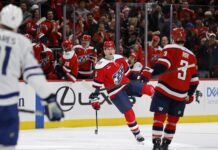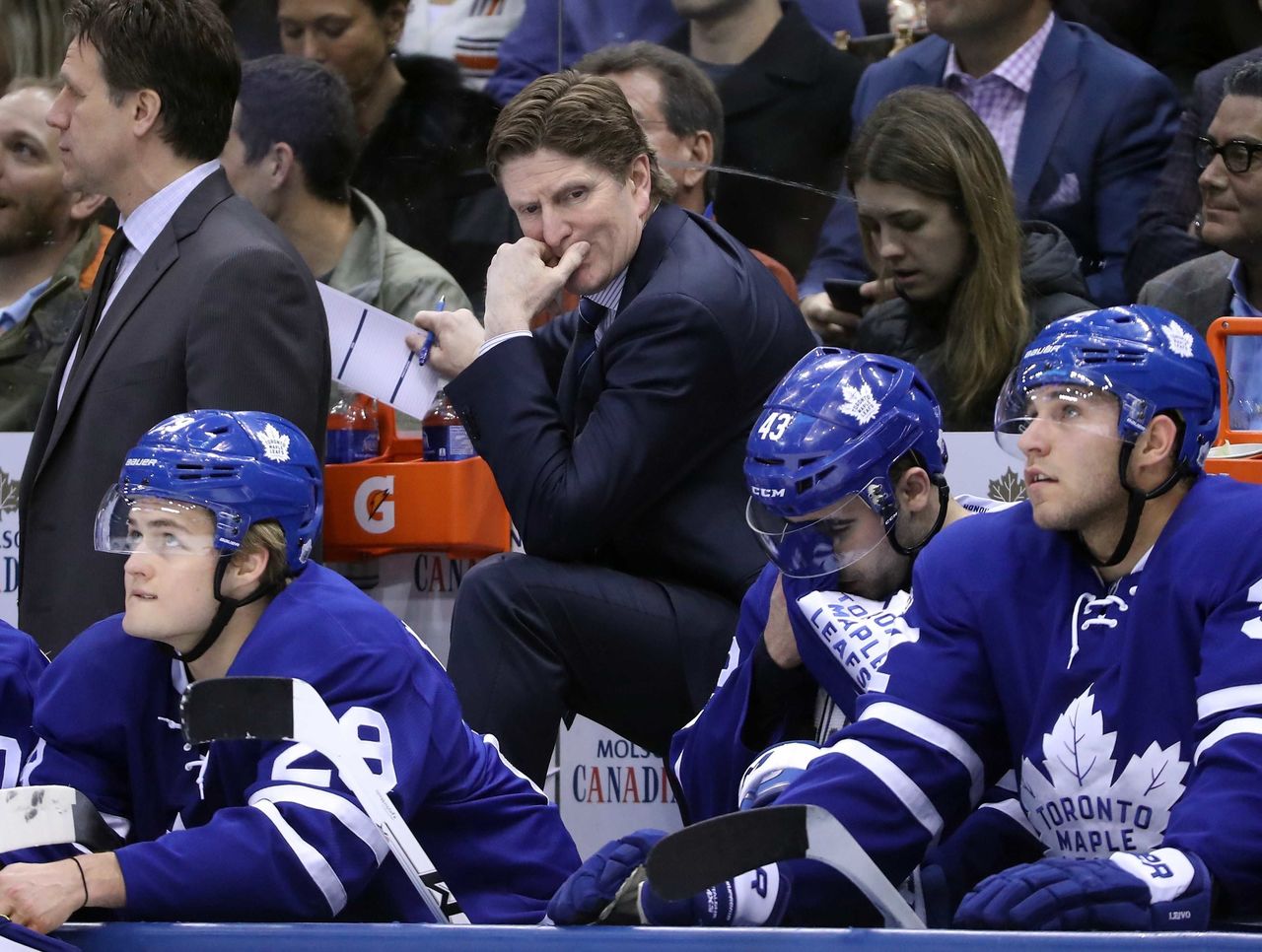This piece was supposed to be about William Nylander and his defensive game, but it changed as it took shape.
We’ll eventually get to him, but the idea morphed as the narrative about the Leafs change in style — leading to improved scoring against results, particularly via high-danger scoring areas — crept into the mainstream. I’ve previously gone over the Leafs‘ high-danger scoring situation leading into December here.
The concept was introduced by Mike Kelly when he tweeted about how the Leafs had adopted a different playing style and limited their high-danger scoring chances against.
The narrative has caught fire. A peripheral positive that came out of this was more exposure to Natural Stat Trick and the site’s availability of high-danger statistics. Paul Romanuk even mentioned it in the broadcast on Thursday night. Using the site, here’s the Leafs‘ breakdown by month at 5v5. Aside from the sumTOI column, the values are average per game.
| Months | sumTOI | Avg 5v5TOI | HDCF | HDCA | HDGF | HDGA | SH% | SV% | SCF | SCA |
|---|---|---|---|---|---|---|---|---|---|---|
| Oct | 562.23 | 46.85 | 10.25 | 7.83 | 1.42 | 1 | 12.01 | 89.73 | 27.58 | 22.5 |
| Nov | 716.08 | 47.74 | 8.8 | 8.67 | 1 | 0.87 | 10 | 93.06 | 22.47 | 22.53 |
| Dec | 291.28 | 48.55 | 8.67 | 7.83 | 1 | 0.33 | 5.77 | 95.86 | 24.5 | 21.33 |
| Avg | 1569.6 | 47.56 | 9.3 | 8.21 | 1.15 | 0.82 | 9.96 | 92.35 | 24.7 | 22.3 |
There have been fewer high-danger scoring chances for and pretty close to the early-season shot attempts against; the difference being the drop in goals against and recent stretch of goaltending. This has been the theme for some time now. The question is: What happened in November to balloon the average HDCA to 8.67 per game?
While scoring chances against haven’t changed much overall, there is a distinct drop in scoring chances for starting in November. Incorporated in the SCA (scoring chances against) is a higher grade of high-danger chance relative to October and December.
Clearly, the Leafs could not be successful playing an open style like they did out of the gate — with such a dreadful save percentage — over an entire season, especially in the playoffs. They cut out some of the risk and scaled back the intensity in some of their forechecking to add safer elements.
They didn’t improve defensively. They just got better goaltending.
They’re less aggressive in the offensive zone — there is less 2-1-2 and they’re not as frantic underneath the goal line, while adopting a “prevent”-style 1-2-2 in the neutral zone (I’d bet a tracker could see more controlled exits from Leafs opponents lately).
Going the other way, gap control in the neutral zone is a key tactic for containing the Leafs, limiting the space for their forwards to pick up speed and force attacks. Loading the neutral zone with bodies isn’t enough; that just creates a static situation with inevitable holes. It’s about strict adherence to a ‘contain’ concept before they get into the offensive zone — where they are dangerous, especially when engaged in a relentless 2-1-2 forecheck.
If the Leafs get past secondary defensive checking layers with speed, they’re a dangerous attacking team with their bevy of skilled forwards.
As for this proposed change in style: Maybe it wasn’t the Leafs alone. Rather, teams are adapting play in order to contain and compel them into adopting a style that includes more dumping the puck into the opposition zone, while still using speed to their advantage to try to retrieve pucks.
I sometimes wonder if this is why the Leafs adopted those long stretch/outlet pass plays, something specifically instilled by Mike Babcock as Leafs coach.
Whether rushing with the puck up the ice or forcing opposition to retreat — allowing for stretch outlet passes — Nylander emerges as an essential in both schemes. Part of this has to do with the way he is constantly in motion while playing at the top of the defensive zone, circling and looking for the moment to cheat/streak out of the zone. That forces the defensemen to be wary of the threat and retreat into center, eventually pushing the defensemen back and opening up a lot of space.
This is the first example. In constant motion, he eventually exits the zone and escapes the forecheck with a long outlet pass.
At the end of the sequence, a few more inches and Komarov would have had a solid scoring chance.
In this next sequence, we see where he supports the rush by coming up with a play from behind the net before covering the point as Zaitsev pinched in to attempt a shot from the half boards.
Nylander adopts this support sequence often, all over in the offensive zone. Here, he covers the point and then realizes both defensemen are back in their positions. So he engages the puck carrier trying to get out of the zone, forcing a bobbled exit that the Leafs then bobbled themselves. They saved themselves a rush and potential scoring chance against as a result.
Nylander recognizing that he is the one that could potentially engage the puck rusher was essential to that play. That might be classified as a forechecking manoeuvre, but it is actually defensive and disrupted the play/momentum. Eventually, it got them the puck back, which is essentially the point of playing defense.
Here, right off the faceoff on what seems to be a set play, Nylander takes off and forces the defenseman to skate out of the zone, chasing them for the long stretch pass.
The play is thwarted at the blue line but, again, it’s the ability to use their speed to create the space to maneuver that is the key point here.
Here it is again just a little later on in the Minnesota Wild game.
Nylander saw a drastic drop in ice time once taken off the first line, as exemplified by the tweet below from Micah Blake McCurdy (courtesy of his site hockeyviz.com, which can be supported through a patreon here).
Leo Komarov: second-most-important leafs forward. pic.twitter.com/hDTji8B9gI
— Micah Blake McCurdy (@IneffectiveMath) December 15, 2017
The narrative of a change in playing style may continue to rage in full force — especially with the comments from Mike Babcock saying he believes the Leafs are playing well, which I interpret as meaning they are playing within the structure he expects them to play in and he will accept some mediocre results in order to get them to implement his ideas fully. To me, the shift in the underlying numbers is indicative of the Leafs tightening up and the opposition forcing them to play an unwanted style.















![John Gruden after the Leafs prospects’ 4-1 win over Montreal: “[Vyacheslav Peksa] looked really comfortable in the net… We wouldn’t have won without him” John Gruden, head coach of the Toronto Marlies](https://mapleleafshotstove.com/wp-content/uploads/2025/09/gruden-post-game-sep-14-218x150.jpg)


















